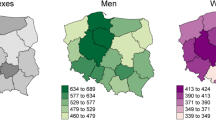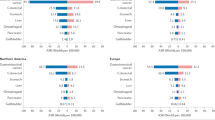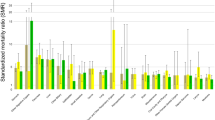Abstract
Detailed data and statistics per each morphological site of various digestive neoplasms were obtained for the period 1976-87 from the Vaud Cancer Registry datafile, a population-based cancer registration scheme covering about 530,000 inhabitants from the French-speaking part of Switzerland. Tabulations presented include absolute number of cases (1,041 oral and pharyngeal, 545 oesophageal, 1,131 gastric, 83 small intestine, 1,980 colon, 1,267 rectal, 357 liver, 328 gallbladder and 725 pancreatic cancers), percent distributions, age-standardised rates, sex ratios and 5-year survival. The report has essentially a descriptive value, and should be viewed as a contribution towards quantification, in a well surveilled population of the West-central part of Europe, of the proportional distribution of digestive neoplasms by morphological type, and corresponding incidence and survival rates. Among the points deserving specific attention, there are the elevated frequency of upper digestive tract cancers, the very high male-to-female ratios for squamous cell carcinomas, adenocarcinomas of the oesophagus and hepatocellular carcinomas of the liver, the female excesses in infiltrating carcinoids of the colon, transitional and squamous cell carcinomas of the rectum and adenocarcinomas of the gallbladder, and the crossover in male-to-female ratio in squamous cell carcinoma along the digestive tract (i.e. from 6.0 at the level of the mouth/pharynx to 0.5 in the rectum). As concerns survival, rates were higher for lymphomas and sarcomas than for carcinomas in oral cavity and stomach, similar for carcinoids and carcinomas in the small bowel (about 35% at 5 years), as well as for colon (34%) and rectal (37%) cancers. Some of the findings, such as the higher survival of carcinomas arising from polyps in the colon and rectum, or the higher proportion of cholangiocellular and combined cholangio- and hepatocellular carcinomas in females than in males find plausible prognostic or aetiologic correlates, but others, such as the large proportions of squamous and transitional cell cancers of the rectum in females are more difficult to explain. These and several other indications emerging from careful examination of the data herein presented underline the interest of morphological analyses of digestive tract cancers.
This is a preview of subscription content, access via your institution
Access options
Subscribe to this journal
Receive 24 print issues and online access
$259.00 per year
only $10.79 per issue
Buy this article
- Purchase on Springer Link
- Instant access to full article PDF
Prices may be subject to local taxes which are calculated during checkout
Similar content being viewed by others
Author information
Authors and Affiliations
Rights and permissions
About this article
Cite this article
Levi, F., La Vecchia, C., Franceschi, S. et al. Morphologic analysis of digestive cancers from the registry of Vaud, Switzerland. Br J Cancer 63, 567–572 (1991). https://doi.org/10.1038/bjc.1991.132
Issue Date:
DOI: https://doi.org/10.1038/bjc.1991.132
This article is cited by
-
Reproductive factors and colorectal cancer
Cancer Causes & Control (1991)



